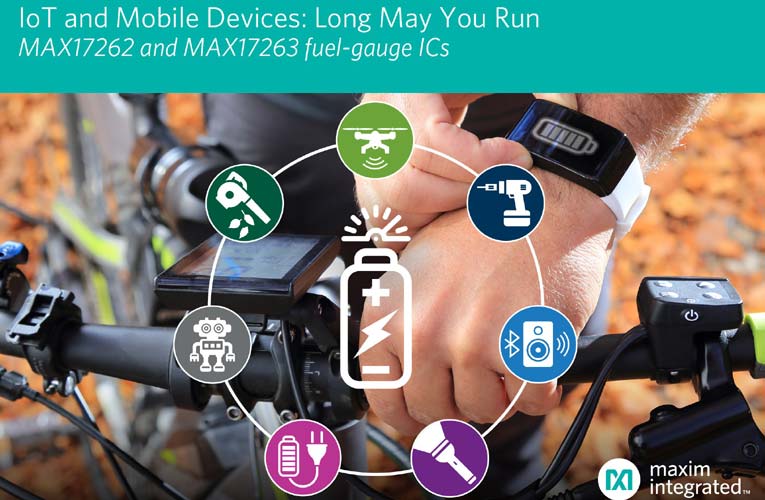
Designers of lithium-ion (Li-ion) battery-powered mobile and portable devices such as wearables, electric bicycles, power tools and internet of things (IoT) products can improve the end-user experience by extending run-time and delivering the most accurate battery state-of-charge (SOC) data in the industry with the MAX17262 single-cell and MAX17263single-/multi-cell fuel-gauge ICs from Maxim Integrated.The MAX17262 features just 5.2μA quiescent current, the lowest level in its class, along with integrated current sensing. The MAX17263 features just 8.2μA quiescent current and drives 3-to-12 LEDsto indicate battery or system status, useful in rugged applications that do not feature a display.
Designers ofelectronic products powered by small Li-ion batteries struggle to extend device run-times to meet user expectations. Factors such as cycling, aging and temperature can degrade Li-ion battery performance over time. Inaccurate SOC data from an unreliable fuel gauge forces the designer to increase the battery size or compromise the run-time by prematurely shutting the system down, even if there is usable energy available. Such inaccuracies can contribute to a poor user experience due to abrupt shutdown or an increase in device charging frequency. Designers also strive to get their products to market quickly due to competitive demands. Maxim’s two new fuel-gauge ICs help designers meet end-user performance expectations and time-to-market challenges.
The MAX17262 and MAX17263 combine traditional coulomb counting with the novel ModelGauge™ m5 EZ algorithm for high-accuracy battery SOC without requiring battery characterization. With their low quiescent current, both fuel-gauge ICs minimize current consumption during long periods of device standby time, extending battery life in the process. Both also have a dynamic power feature that enables the highest possible system performance without draining the battery. In the MAX17262, an integrated RSENSE current resistor eliminates the need to use a larger discrete part, simplifying and reducing the board design. In the MAX17263, the integrated, push button LED controller further minimizes battery drain and alleviates the microcontroller from having to manage this function.
Key Advantages
- High Accuracy: The ICs provide accurate time-to-empty, time-to-full, SOC(1 percent) and mAhr data across a wide range of load conditions and temperatures, using the proven ModelGauge m5 algorithm
- Fast Time to Market: The ModelGauge m5 EZ algorithm eliminates the time-consuming battery-characterization and calibration process
- ExtendedRun-Time: Quiescent current of just 5.2μA for the MAX17262 and 15/8.2μA for MAX17263 extends run-time
- Integration: Internal current-sense resistor (voltage and coulomb counting hybrid) in MAX17262 reduces overall footprint and BOM cost, eases board layout. It measures up to 3.1A and is suitable for batteries of 100mAhr to 6Ahr capacity. For applications using higher currents or battery capacity outside this range, the MAX17263, or the MAX17260 released recently, can be used with an external current sense resistor of any size
- Small size: At 1.5mm × 1.5mm IC size, the MAX17262 implementation is 30 percent smaller in size compared to using a discrete sense resistor with an alternate fuel gauge; at 3mm × 3mm, MAX17263 is the smallest in its class for lithium-ion-powered devices
- LED Support: The single-/multi-cell MAX17263 also drives LEDsto indicate battery status on a push button press or system status on system microcontroller commands

